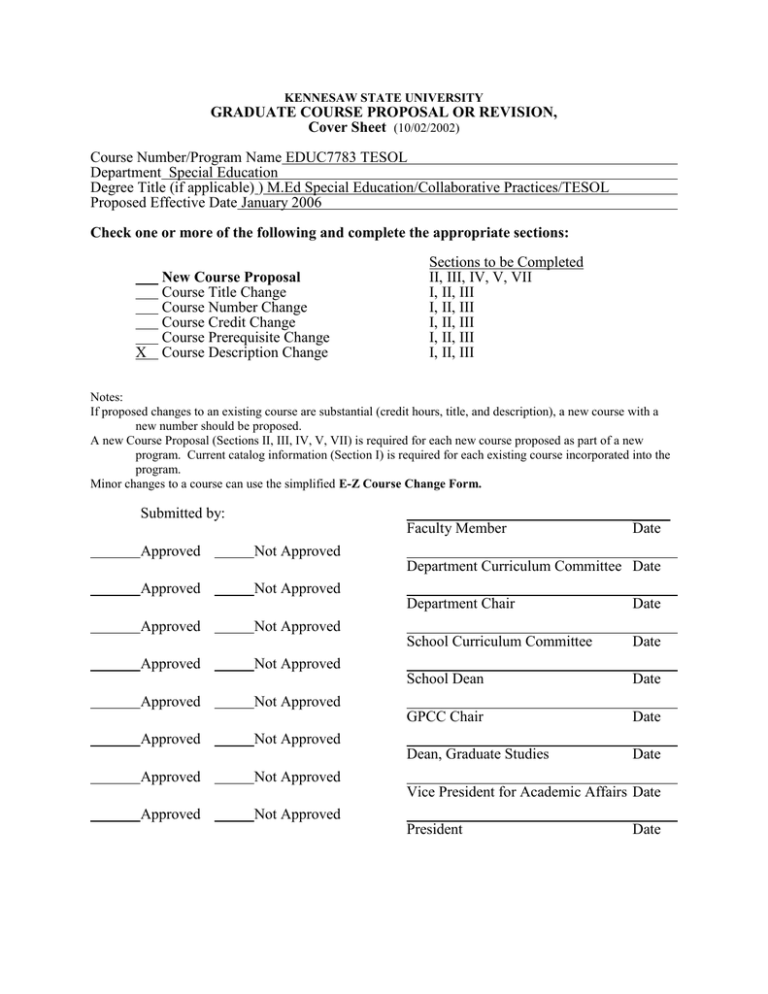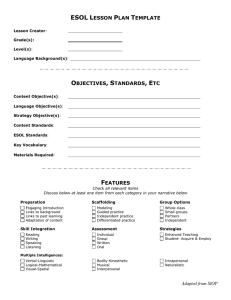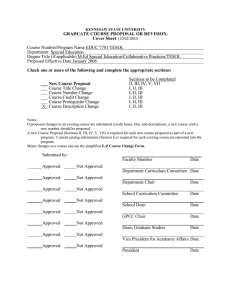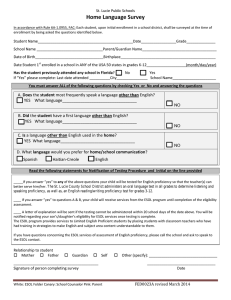GRADUATE COURSE PROPOSAL OR REVISION, Cover Sheet Course Number/Program Name EDUC7783 TESOL
advertisement

KENNESAW STATE UNIVERSITY GRADUATE COURSE PROPOSAL OR REVISION, Cover Sheet (10/02/2002) Course Number/Program Name EDUC7783 TESOL Department Special Education Degree Title (if applicable) ) M.Ed Special Education/Collaborative Practices/TESOL Proposed Effective Date January 2006 Check one or more of the following and complete the appropriate sections: X New Course Proposal Course Title Change Course Number Change Course Credit Change Course Prerequisite Change Course Description Change Sections to be Completed II, III, IV, V, VII I, II, III I, II, III I, II, III I, II, III I, II, III Notes: If proposed changes to an existing course are substantial (credit hours, title, and description), a new course with a new number should be proposed. A new Course Proposal (Sections II, III, IV, V, VII) is required for each new course proposed as part of a new program. Current catalog information (Section I) is required for each existing course incorporated into the program. Minor changes to a course can use the simplified E-Z Course Change Form. Submitted by: Faculty Member Approved _____ Date Not Approved Department Curriculum Committee Date Approved Approved Approved Approved Approved Approved Not Approved Department Chair Date School Curriculum Committee Date School Dean Date GPCC Chair Date Dean, Graduate Studies Date Not Approved Not Approved Not Approved Not Approved Not Approved Vice President for Academic Affairs Date Approved Not Approved President Date KENNESAW STATE UNIVERSITY GRADUATE COURSE/CONCENTRATION/PROGRAM CHANGE I. Current Information (Fill in for changes) Page Number in Current Catalog p. 112 Course Prefix and Number Course Title Credit Hours Prerequisites Description (or Current Degree Requirements) In this course, prospective ESOL teachers will develop skills in writing and adapting curricula, critiquing and selecting materials, and applying strategies for teaching reading, writing, speaking and listening to speakers of other languages. The course will also include assessment of linguistic proficiency and development. II. Proposed Information (Fill in for changes and new courses) Course Prefix and Number ________________________________ Course Title _________________ ________ Credit Hours Prerequisites Description (or Proposed Degree Requirements) In this course, prospective ESOL teachers will develop skills in writing and adapting curricula, critiquing and selecting materials, and applying strategies for teaching reading, writing, speaking and listening to speakers of other languages. The course will also include assessment of linguistic proficiency and development. . III. Justification The Department of Special Education at Kennesaw State University has historically offered a program in Collaborative Practices, with endorsement in ESOL. The proposed changes in this course are necessary to bring the exiting endorsement program into alignment with national TESOL standards. Many of the research-based practices for students with disabilities are also efficacious for students who are culturally and linguistically diverse. This effort will pave the way for classroom teachers in Georgia to educate all students within the Georgia Performance Standards, including those who have disabilities and those who are culturally and linguistically diverse. The purpose of this course is to acquaint candidates with a variety of techniques and materials that will help them be effective ESOL teachers. It will also include information about assessment. During the course candidates will develop a portfolio of approaches, techniques, materials, and resources that match their philosophy of language acquisition. IV. Additional Information (for New Courses only) Instructor: Text: Prerequisites: Objectives: Instructional Method Method of Evaluation - V. Resources and Funding Required (New Courses only) Resource Amount Faculty Other Personnel Equipment Supplies Travel New Books New Journals Other (Specify) TOTAL Funding Required Beyond Normal Departmental Growth VI. COURSE MASTER FORM This form will be completed by the requesting department and will be sent to the Office of the Registrar once the course has been approved by the Office of the President. The form is required for all new courses. DISCIPLINE COURSE NUMBER COURSE TITLE FOR LABEL (Note: Limit 16 spaces) CLASS-LAB-CREDIT HOURS Approval, Effective Term Grades Allowed (Regular or S/U) If course used to satisfy CPC, what areas? Learning Support Programs courses which are required as prerequisites APPROVED: ________________________________________________ Vice President for Academic Affairs or Designee __ VII Attach Syllabus I. EDUC 7783 Methods and Materials for Teaching ESOL Department of Special Education Kennesaw State University Spring 2006 II. Instructor: Name: Office: Phone: e-mail: III. Class Sessions: Day and Time: Place: IV. M 5:00-8:00 pm KH Text: Celce-Murcia, M. (2001). Teaching English as a second or foreign language. United States: Heinle & Heinle V. Catalogue Description: Prerequisite: Admission to M.Ed. program or ESOL endorsement program and EDUC 7781 and EDUC 7782. In this course, prospective ESOL teachers will develop skills in writing and adapting curricula, critiquing and selecting materials, and applying strategies for teaching reading, writing, speaking and listening to speakers of other languages. The course will also include assessment of linguistic proficiency and development. VI. Purpose/Rationale: The purpose of this course is to acquaint candidates with a variety of techniques and materials that will help them be effective ESOL teachers. It will also include information about assessment. During the course candidates will develop a portfolio of approaches, techniques, materials, and resources that match their philosophy of language acquisition VII. Conceptual Framework Summary & Related Requirements Collaborative Development of Expertise in Teaching and Learning. The Kennesaw State University teacher education faculty is committed to preparing teachers who demonstrate expertise in facilitating learning in all students. Toward that end, the KSU teacher education community strongly upholds the concept of collaborative preparation requiring guidance from professionals inside and outside the university. In tandem with this belief is the understanding that teacher expertise develops along a continuum which includes the stages of preservice, induction, in-service, and renewal; further, as candidates develop a strong research-based knowledge of content and pedagogy, they develop their professional expertise in recognizing, facilitating, assessing, and evaluating student learning. While completing your graduate program at Kennesaw State University, you are required to be involved in a variety of leadership and school-based activities directed at the improvement of teaching and learning. Appropriate activities may include, but are not limited to, attending and presenting at professional conferences, actively serving on or chairing school-based committees, attending PTA/school board meetings, leading or presenting professional development activities at the school or district level, and participating in education-related community events. As you continue your educational experiences, you are encouraged to explore every opportunity to learn by doing. Knowledge Base. Teacher development is generally recognized as a continuum that includes four phases: preservice, induction, in-service, renewal (Odell, Huling, and Sweeny, 2000). Just as Sternberg (1996) believes that the concept of expertise is central to analyzing the teaching-learning process, the teacher education faculty at KSU believes that the concept of expertise is central to preparing effective classroom teachers and teacher leaders. Researchers describe how during the continuum phases teachers progress from being Novices learning to survive in classrooms toward becoming Experts who have achieved elegance in their teaching. We, like Sternberg (1998), believe that expertise is not an end-state but a process of continued development. The knowledge base for methods of teaching students with disabilities continues to develop rapidly. The historical framework included perceptual training, behavior modification and task analysis. Current directions include multiple intelligence models, systematic instruction, strategy approaches to teaching and learning, and direct instruction. The field draws on research literature from educational psychology, medicine, psychology and special education. The emphasis in this class will be on developing skills in application of research-based best practice in the area of behavior management, documenting impact on student learning, and reflective practice. Technology Standards Telecommunication and information technologies will be integrated throughout the master teacher preparation program, and all candidates must be able to use technology to improve student learning and meet Georgia Technology Standards for Educators. During the courses, candidates will be provided with opportunities to explore and use instructional media, especially microcomputers, to assist teaching. They will master use of productivity tools, such as multimedia facilities, local-net and Internet, and feel confident to design multimedia instructional materials, create WWW resources, and develop an electronic learning portfolio. Candidates in this course will be expected to apply the use of educational technology in classrooms for students in their classrooms. Specifically, candidates will use spreadsheet software to develop graphs, charts, and tables, word processing to write papers, and e-mail to communicate with the instructors and their peers. Diversity Standards A variety of materials and instructional strategies will be employed to meet the needs of the different learning styles of diverse learners in class. Candidates will gain knowledge as well as an understanding of differentiated strategies and curricula for providing effective instruction and assessment within multicultural classrooms. One element of course work is raising candidate awareness of critical multicultural issues. A second element is to cause candidates to explore how multiple attributes of multicultural populations influence decisions in employing specific methods and materials for every student. Among these attributes are age, disability, ethnicity, family structure, gender, geographic region, giftedness, language, race, religion, sexual orientation, and socioeconomic status. An emphasis on cognitive style differences provides a background for the consideration of cultural context. Kennesaw State University provides program accessibility and accommodations for persons defined as disabled under Section 504 of the Rehabilitation Act of 1973 or the Americans with Disabilities Act of 1990. A number of services are available to support students with disabilities within their academic program. In order to make arrangements for special services, students must visit the Office of Disabled Student Support Services (ext. 6443) and develop an individual assistance plan. In some cases, certification of disability is required. Please be aware there are other support/mentor groups on the campus of Kennesaw State University that address each of the multicultural variables outlined above. Professional Portfolio Requirements As you know…”..a required element in each portfolio for the Graduate Program is the portfolio narrative. The purpose of the portfolio narrative is to ensure that every candidate reflects on each of the proficiencies on the CPI with regard to what evidence the candidate has selected for his/her portfolio. In your portfolio, you need to include a narrative, which includes descriptive, analytic and reflective writing in which you reflect on each of the proficiencies and how you make the case that the evidence you have selected in your portfolio supports a particular proficiency, using the Portfolio Narrative Rubric as a guide. The narrative should be comprehensive, documenting research-based best practices. In this class you will do projects that have been specifically designed to assist you in portfolio development. For example, you will videotape you and a coteaching engaging in one of the five most common approaches to co-teaching in a general education classroom. A videotaped lesson, along with critical analysis, is a required element for graduation from the Bagwell College of Education. Therefore, attend carefully to the assignments in this course and how they will assist you in meeting future college requirements. Extensions. Candidates should keep ongoing documentation of ways in which they extended their learning and skills from this and other courses. For this course, this could include identifying students who gain access to more inclusive educational environments, actual changes implemented in the school as a result of the Building Plan, changes in student behavior or learning that results from co-teaching, interactions with parents, committees formed or served on related to inclusive education, peer mediated strategies implemented in your class or other classrooms, workshops on co-teaching conducted at the school, the establishment of additional co-teaching teams at your school and etc. Impact on Student Learning Analysis It is our assumption that you are already assessing the influence of your instruction on your students’ learning and that you are considering what factors, such as student diversity, might affect your students’ achievement. For this assignment, you will select a lesson, activity, unit, or skill that you plan to teach this semester and analyze its impact on your students’ learning. Then, you will reflect on the impact on your students’ learning on that particular lesson, activity, unit, or skill using the “Impact on Student Learning Analysis” Rubric as a guide. You will want to consider how the differences that every student brings to the classroom setting may have influenced learning (see definition of “every student” at the top of attached “Impact on Student Learning” rubric). Unless your program area tells you differently, the length of the reflection is up to you, but it should be concise. (See Directions for “Impact on Student Learning Analysis” that accompanies the Rubric for greater detail.) Graduate Field Experience Requirements While completing your graduate program at Kennesaw State University, you are required to be involved in a variety of leadership and school-based activities directed at the improvement of teaching and learning. Appropriate activities may include, but are not limited to, attending and presenting at professional conferences, actively serving on or chairing school-based committees, attending PTA/school board meetings, leading or presenting professional development activities at the school or district level, and participating in education-related community events. As you continue your educational experiences, you are encouraged to explore every opportunity to learn by doing. VIII. Course Standards, Outcomes, Performance Indicators & Objectives The KSU teacher preparation faculty is strongly committed to the concept of teacher preparation as a developmental and collaborative process. Research for the past 25 years as described this process in increasingly complex terms. Universities and schools must work together to successfully prepare teachers who are capable of developing successful learners in today’s schools and who choose to continue their professional development. For the purposes of this syllabus, course goals and objectives are first delineated according to development of candidate knowledge, skills & dispositions and then crossreferenced to the national professional standards of the Council for Exceptional Children and Teachers of Speakers of Other Languages. TESOL Performance Indicators* 3.c.1. Select, adapt and use culturally responsive, ageappropriate, and linguistically accessible materials. 3.c.2. Select materials and other resources that are appropriate to students’ developing language and content-area abilities, including the use of L1. 1.b.1 Provide rich exposure to English 1.b.2. Provide comprehensible input and scaffolding 3.a.1 Plan standards-based ESL & content instruction. 3.a.2. Create environments that promote standards-based language learning in supportive, accepting classrooms & schools. 3.a.3. Plan learning experiences based on assessment of language proficiency and prior knowledge. 1.b.3. Provide opportunities for meaningful interactions. 1.b.4. Create a secure, positive, and motivating learning environment. 3.c.3. Employ an appropriate variety of materials for language learning, including CPI Outcomes & Proficiencies NCATE Standards CPI Outcome 1: SME 1.1; 1.2; 1.3;.l.4 CPI Outcome 2: FL 2.1; 2.2; 2.4 CPI Outcome 3: CP 3.1;.3.2 Course Objectives 1) Discuss appropriate approaches, methods and materials for different grades and proficiencies Evidence of Mastery List of 15 activities NCATE Standard I (KSD) NCATE Standard II (Diversity) CPI Outcome 1: SME 1.1; 1.2; 1.3; 1.4 CPI Outcome 2: FL 2.1; 2.2; 2.4 NCATE Standard I (KSD) NCATE Standard II (Diversity) CPI Outcome 1: SME 1.1; 1.2; 1.3; 1.4 CPI Outcome 2: FL 2.1; 2.2; 2.3; 2.4 NCATE Standard I (KSD) NCATE Standard II (Diversity) 2) Analyze commercial ESOL products and understand how and why to adapt commercial products to specific pedagogical situations 3) Analyze the GPS’s ESOL instruction in content areas 4) Analyze traditional methodologies in ESOL instruction 5) Plan lesson List of products Quiz 6) Develop skills in teaching the four language skills (reading, writing, speaking, & listening) 7) Understanding why and how to use realia in the classroom Microteaching and lesson plans Creation of picture file books, visual aids, props and realia. 3.c.4. Use technological resources to enhance language and content-area instruction for ESOL students. 3.c.5. Use software and Internet resources effectively in ESOL and content instruction. 3.c.3. Employ an appropriate variety of materials for language learning, including books, visual aids, props and realia. 3.c.4. Use technological resources to enhance language and content-area instruction for ESOL students. 4.b.1. Understand and implement national & state requirements for identification, reclassification and exit of ESOL students from language support programs. 3.a.3. Plan (and implement) learning experiences based on assessment of language proficiency and prior knowledge. 4.a.1. Demonstrate understanding of purposes of ESOL assessment and the appropriate use of results. 4.a.3. Demonstrate understanding of limitations of assessment for ESOL & appropriate accommodations for students. 4.b.1. Understand and implement national & state requirements for identification, reclassification and exit of ESOL students from language support programs. 4.c.1. Use performance-based assessment tools and tasks that measure ESOL learners’ progress toward state and national standards. 8) Reflect on how materials reflect language teaching philosophy Discussion CPI Outcome 1: SME 1.1; 1.2; 1.3; 1.4 CPI Outcome 2: FL 2.1; 2.2; 2.4 9) Analyze the relationship between formal language instruction and language acquisition Microteaching and lesson plans NCATE Standard I (KSD) NCATE Standard II (Diversity) 10) Examine techniques for giving corrective feedback CPI Outcome 1: SME 1.1; 1.2; 1.3; 1.4 CPI Outcome 2: FL 2.1; 2.2; 2.3; 2.4; 2.5; 2.6 CPI Outcome 3: CP 3.1; 3.2 11) Examine Assessment Techniques for ESOL students Discussion 12) Examine language proficiency assessment Discussion CPI Outcome 1: SME 1.1; 1.2; 1.3; 1.4 CPI Outcome 2: FL 2.1; 2.2; 2.3; 2.4 NCATE Standard I (KSD) NCATE Standard II (Diversity) NCATE Standard I (KSD) NCATE Standard II (Diversity) CPI Outcome 1: SME 1.1; 1.2; 1.3; 1.4 CPI Outcome 2: FL 2.1; 2.2; 2.3; 2.4; 2.5; 2.6 CPI Outcome 3: CP 3.1; 3.2 NCATE Standard I (KSD) NCATE Standard II (Diversity Exam Exam 4.c.2. Use various instruments and techniques to assess content-area learning. 4.c.3. Prepare ESOL students to use self-assessment and peer assessment techniques when appropriate. * TESOL Standards addressed in this course are: 1.b. 3.a. 3.c. 4.a. 4.b. 4.c. IX. Language Acquisition and Development Planning for Standards-Based ESL & Content Instruction Using Resources Effectively in ESL Instruction Issues of Assessment for ESL Language Proficiency Assessment Classroom-Based Assessment for ESL Course Requirements: Assignment 1) Materials examination 2) List of 15 activities 3) 4) 5) 6) Microteaching and lesson plan Creation of 20 item picture file Quiz Participation in discussion Points Assessed 20 20 20 20 10 10 Explanation of Assignments 1) Materials examination We will examine several commercial products in class. You will choose two and write a one page critique of each. Here are some questions to answer: - What is the age and proficiency target? - Does it coincide with your language teaching philosophy? - What is the emphasis? (reading, speaking etc.) - Overall evaluation? - Look at the textbook evaluation form on pages 425-427 2) List of 15 activities I will be handing out materials with ideas about specific activities in class. I will also point out websites with ideas. I want you to select 15 during the semester. Write a short description of the activity and why YOU think it has real pedagogical and linguistic value. No specific length here. May one page each but could be shorter or longer. You must also list the where the activity came from: website, book etc. 3) Lesson plan and presentation Each student will present a develop a lesson plan for some aspect of ESL. You may choose vocabulary development, grammar, listening skills, pronunciation etc. You then take five minutes and tell the class about your lesson plan. Things to think about: - What skill are you targeting? - How proficient are the learners? - How would you assess the material? 4) Creation of 20 item picture file Realia is a wonderful language learning tool. Find 20 magazine pictures that are good for language learning and are cultural appropriate. 5) Quiz A short quiz over “traditional” methodologies 6) Participation Candidates are expected to participate in all discussions. X. Evaluation and Grading: A 100 to 90 B 89 to 80 C 79 to 70 D 69 to 60 F 59 and below XI. Academic Honesty Statement Page 116 of the KSU Graduate catalog (2000 - 2001) states: KSU expects that graduate candidates will pursue their academic programs in an ethical, professional manner. Any work that candidates present in fulfillment of program or course requirements should represent their own efforts, achieved without giving or receiving any unauthorized assistance. Any student who is found to have violated these expectations will be subject to disciplinary action. XII. Class Attendance Policy Since we only have 14 class days, it is vital that you attend each day. However, circumstances do arise that make attendance impossible. Therefore, you may miss two classes with no penalty. After two, each absence will result in a 2.5 grade reduction. XIII. Course Outline All Reading Assignments are from Teaching English as a Second or Foreign Language Date Topics/Activities/In-Class Assignments Introduction, Traditional Methodologies Communicative Language Teaching Listening Skills Speaking Skills Reading Writing Assignment pp. 3-10 pp. 13-27 Quiz pp. 69 - 84 20 pictures pp. 139 - 149 pp. 153 - 168 pp. Content-based approaches Lesson plans Assessment Teaching adults 15 activities pp. 303 - 318 pp. 515 - 530 Lesson plan Critique of resources IVX. Bibliography Odell, S. J., Huling, L., & Sweeny, B. W. (2000). Conceptualizing quality mentoring, background information. In S. J. Odell & L. Huling (Eds.), Quality mentoring for novice teachers (pp. 3-14). Indianapolis, IA: Kappa Delta Pi. Sternberg, R. J. (1996). Educational psychology has fallen, but it can get up. Educational psychology review, 8(2), 175-185. Sternberg, R. J. (1998). Metacognition, abilities, and developing expertise: What makes an expert student? Instructional Science, 26, 127-140. Asher, J. (1977). Learning another language through actions: The complete teacher's guidebook. Los Gatos: Sky Oaks Publications. Bialystyok, E. & Hakuta, K. (1994). In other words: The science and psychology of second-language acquisition. New York: Basic Books. Canale, M. & Swain, M. (1980). Theoretical bases of communicative approaches to second language teaching and testing. Applied linguistics, 1, 1-47. Brown, H. D. & Gonzo, S. (Eds.). (1995). Readings on second language acquisition. Englewood Cliffs, NJ: Prentice Hall. Ford, C. (1997). 101 bright ideas: ESL activities for all ages. Addison-Wesley. Fu, D. (1995). My problem is my English: Asian students and the American dream. Portsmith N.H.: Boyton/Cook Publishers. Gardner, R. & Lambert, W. (1972). Attitudes and motivation in second language learning. Rowley, Mass.: Newbury House. Herrell, A. (2000). Fifty strategies for teaching English language learners. Upper Saddle River, New Jersey: Prentice-Hall. Klippel, F. (2000). Keep talking: Communicative fluency activities for language teaching. Cambridge: Cambridge University Press. Krashen, S. & Terrel, T. (1983). The natural approach: Language acquisition in the classroom. Oxford: Pergamon. Larsen-Freeman, D. (2000). Techniques and principles in language teaching. Oxford: Oxford University Press. Lightbrown, P. (2000). Classroom SLA research and second language teaching. Applied linguistics 21 431-462. Lightbrown, P. and N. Spada. (1999). How languages are learned. 2nd ed.. Oxford: Oxford University Press. Savignon, S. (1983). Communicative competence: Theory and classroom practice. Reading: Addison-Wesley. Sion, C. (1991). More Recipes for tired teachers. Canterbury: Addison-Wesley. Sion, C. (1983). Recipes for tired teachers. Canterbury: Addison-Wesley. Ur, P. & Wright, A. (2001). Five-minute activities: A resource book of short activities. Cambridge: Cambridge University Press.






